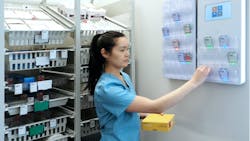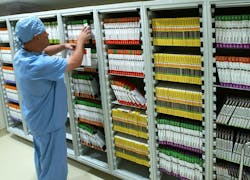Supply Safari: The Wild World of Warehouses and Storerooms
There was a time not too long ago when supply chain operators were hospital basement dwellers, emerging from their lairs only to cycle count and replenish. But what a transformation has taken place over the past decade! The hospital supply chain has evolved into a strategic powerhouse, with warehouses and storerooms emerging as linchpins in the efficient management of healthcare supplies. Let's explore the transformative journey of these spaces, once considered mere storage areas but now pivotal in optimizing healthcare logistics and, by extension, patient care quality.
Historically, hospital storage areas were simple and functional. They served as basic repositories for medical supplies, with minimal emphasis on technology or strategic management. Fundamentally, of course, this is still what they are. But there was a bit of a collective light bulb that went on when hospital after hospital, supply chain leader after supply chain leader, started paying attention to loss and expiry, recalls and reconciliation. Supplies are the second highest expense in healthcare delivery, following labor. This is a massive expense line that demanded more strategic oversight.
And so, healthcare supply chain ascended from the basement and took a seat at the table. The very function of warehouses, storerooms, and distribution centers would evolve over the next decade to that of a clinically integrated networked operation. Today, driven by the need for efficiency and accuracy, accelerated by the adoption of advanced technologies such as artificial intelligence (AI), robotics, and data analytics, these spaces have both transformed the physicality of warehouses and storerooms and redefined their operational ethos.
The Shift from Siloes to Networks
Nearly every health system has a combination of warehouses and storerooms. Rather than working as siloed operations, these facilities are now almost always part of a larger, more integrated system that relies on centralized management.
Currently, a growing trend in hospital logistics is the operation of a consolidated service center (CSC) at the warehouse level, which feeds supplies into the technologically equipped storerooms. This approach has become increasingly common and significantly enhances how supplies are managed across the entire healthcare facility's supply chain. The ecosystem comprises storerooms within the hospital and an offsite CSC, working in tandem to manage supplies more effectively with the aid of advanced technology.
This integration has transformed the nature of inventories and the management of materials, aiming to create a seamless process that reliably and efficiently services the storerooms. It is the synergy between the warehousing facilities and the in-hospital storerooms that is key to an optimized supply chain, ensuring it can support immediate patient care needs effectively. This interplay is vital in maintaining a smooth, responsive supply chain that is essential for high-quality healthcare delivery.
The Adoption of Supply Chain Management Technology
In the past, supply chain management in healthcare was heavily reliant on manual processes. Supply technicians would count inventory levels and reorder supplies using paper forms. This method, while straightforward, was time consuming and prone to errors.
Hospitals and healthcare facilities prioritize quality outcomes alongside financial considerations, which tamps down accelerated technology adoption. This strong dedication to patient care, coupled with an inherent risk aversion, means that healthcare supply chain leaders are typically more cautious about adopting the latest technologies, often a step or two behind other industries. Instead, they focus on implementing technologies and processes that enhance patient care while ensuring safety and reliability.
Despite that conservatism, there are several proven and reliable technologies that are finding their way into more healthcare organizations today. Whether a health network is operating a CSC or a more traditional siloed supply chain operation, it has become a necessity in order to operate at the level and efficiency that the industry demands.
Over time, the supply chains have integrated more sophisticated systems at the application level, significantly enhancing efficiency in the storeroom. In warehouses, automation has evolved to include industry-standard systems that are continually advancing.
Now, the healthcare supply chain makes extensive use of barcodes, radio frequency identification devices (RFID), and advanced technologies like voice activation, artificial intelligence, predictive demand planning, and robotics. These innovations have revolutionized storerooms, enabling precise tracking of expiration dates, serial numbers, and lot numbers.
The Case for Automation Within Storerooms and Warehouses
Given the pressure on hospital systems to manage financial resources wisely, the ROI calculation for automation becomes increasingly favorable as the cost of these technologies decreases and the cost of labor increases. With more vendors and options entering the automation market, the costs are becoming more manageable, making automation an appealing alternative to hiring additional staff.
In warehouses where robots are deployed, they play a vital role in packing and palletizing goods, streamlining the distribution process significantly. The precision and speed of these robots ensure that orders are prepared accurately and dispatched promptly, enhancing the overall responsiveness of the supply chain. More traditional warehouse automation systems like automated sortation and conveyors can drive higher efficiencies. Space utilization can be maximized with goods-to-person systems like ASRS and vertical lifts. Automatic guided vehicles (AGVs) or autonomous mobile robots (AMRs) can help in picking, packing, sorting, and storing. The world of automation is coming to life, and it promises to change the look of healthcare warehouses and storerooms in the future.
Healthcare supply chain leaders face a weighty decision: whether to invest in more staffing or to shift towards a setup that includes more robotics and automation. Looking to the future, decision makers will need to carefully weigh the financial implications, workforce availability, and operational efficiency to determine the optimal balance between technology integration and human capital. This balance is key to deciding which approach is easier and more effective to manage in the ever-evolving landscape of healthcare.
Bringing It All Together
Warehouses and storerooms, serving as the backbone of the healthcare supply chain, are responsible for maintaining adequate inventory levels and ensuring the integrity and quality of medical supplies. Effective warehouse management, facilitated by advancements in technology and automation, ensures that supplies are not only stored correctly but are also distributed efficiently and accurately to various storerooms across healthcare facilities. This careful orchestration helps to prevent issues such as stockouts, expired supplies, and inventory mismanagement, all of which can critically impact patient care.
Looking ahead at the future of storerooms and warehouses in healthcare, it appears evident that integrating physical spaces with technology is key to creating an efficient supply chain ecosystem. The operational paradigm shift brought about centralization and the CSC model. The maturation of various technologies is now providing compelling use cases around data-driven optimization and system-driven processes. The ongoing labor challenges across the country present interesting ROI trade-offs between investment in automation and talent shortages.
The role of warehouses and storerooms in healthcare goes well beyond storage and inventory management. The future will see physical warehousing and storerooms seamlessly linked with software systems to enhance efficiency, but every health system will chart very different courses to get there and travel at very different speeds. As healthcare continues to evolve, the strategic management of these facilities will remain crucial in upholding and enhancing the integrated supply chain practice and, in turn, care delivery.
About the Author

Cory Turner
Cory Turner CMRP leads Healthcare Strategy for Tecsys, one of the largest supply chain IT organizations in the healthcare industry. He has two decades of experience in healthcare supply chain operations and solutioning, having earned his credentials at Greenville Health System, (now PRISMA Health), the largest IDN in South Carolina. He has since built his career with experience with Infor, Omnicell and Workday solutions. Cory’s insights into the healthcare supply chain market are distinctively informed by his tenure as both an operator and provider of SCE software.



